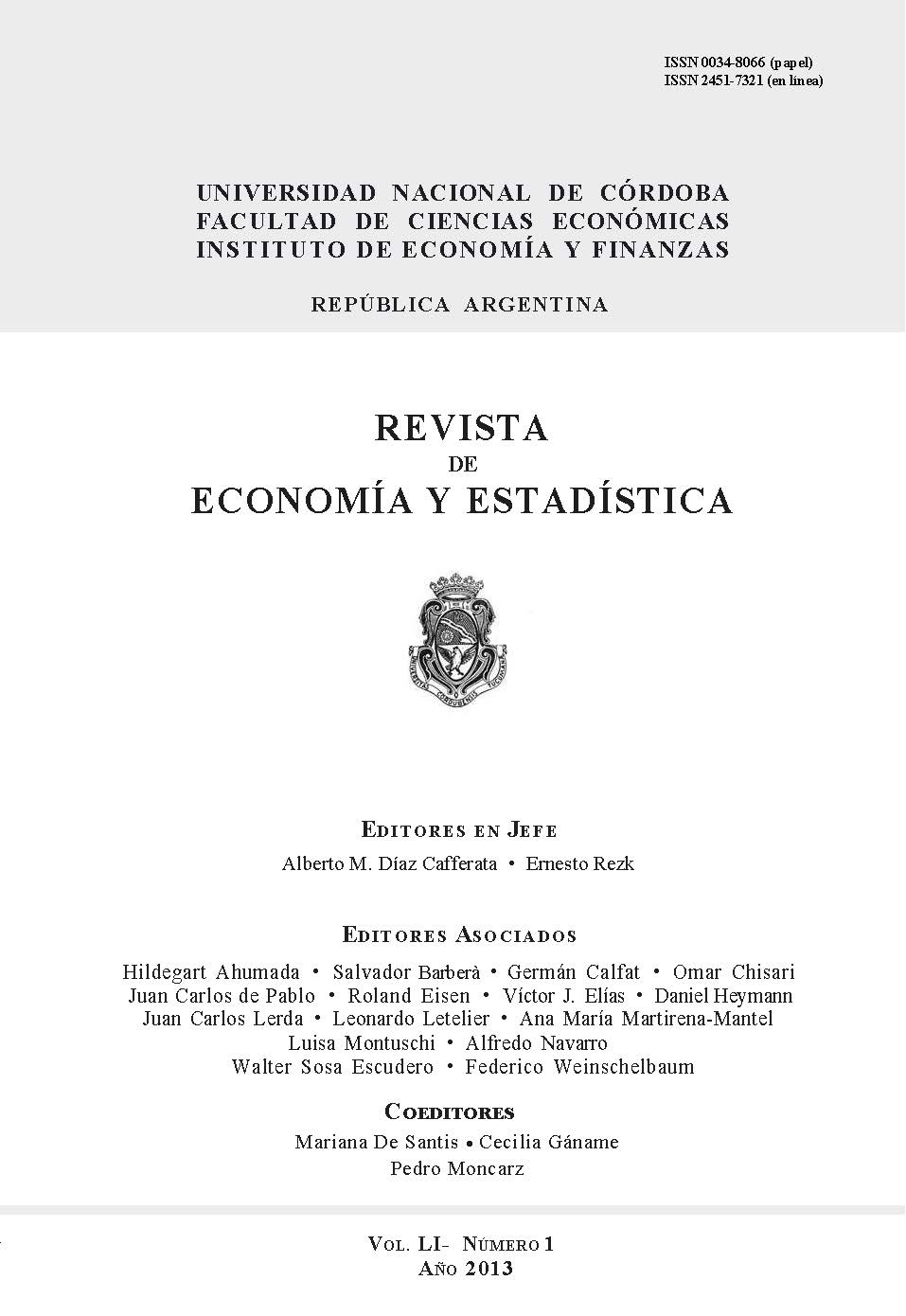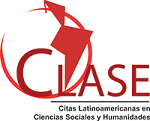Endogenous Tariffs in a Common-Agency Model: A New Empirical Approach Applied to India
DOI:
https://doi.org/10.55444/2451.7321.2013.v51.n1.11875Keywords:
India, political economy, protectionAbstract
This paper proposes a new method to test the Grossman-Helpman model of endogenous protection and lobby formation, which does not require data on lobby formation or contributions. It identifies politically organized industries using commonly available trade and production data, as well as the model's structural parameter estimates. Applied to India, it yields results that are qualitatively consistent with the model's predictions and that seem quantitatively more plausible than estimates given for the US by alternative methods. Our estimates imply that the weight put by the Indian government on contributions by politically organized sectors is a third of the weight it puts on (gross) social welfare, well above existing estimates for the United States.
Downloads
References
Baldwin, R. (1985). “The Changing Nature of US Trade Policy Since World War II”. In R. Baldwin and A. Krueger, eds., The Structure and Evolution of Recent US Trade Policy. University of Chicago Press for NBER.
Becker, G. (1983). “A Theory of Competition among Pressure Groups for Political Influence”. Quarterly Journal of Economics, 98(3), 371-400.
Bernheim, D. and Whinston M. (1986a). “Menu Auctions, resource allocation, and economic influence”. Quarterly Journal of Economics, 101(1), 1-31.
Bernheim, D. and Whinston M. (1986b). “Common agency”. Econometrica, 54(4), 923-942.
Cadot, O., de Melo, J., and Olarreaga M.(2003), “The protectionist bias of duty drawbacks: evidence from Mercosur", Journal of International Economics 59 (1), 161-182.
Cadot, O., de Melo, J., and Olarreaga M. (2004).“Lobbying, counterlobbying and the structure of tariff protection in poor and rich countries”. World Bank Economic Review, 18 (3), 1-22.
Damania, R., and Frederiksson P. (2007). “Trade Policy: What's Welfare Got to Do With It?”. Economic Letters, 96(1), 64-69.
Gawande, K., and Bandyopadhyay, S. (2000). “Is protection for sale? A test of the Grossman-Helpman Theory of Endogenous Protection”. Review of Economics and Statistics, 82(1), 139-152.
Gawande, K., and Krishna, P. (2005). “Lobbying Competition Over US Trade Policy”. NBER Working Paper 11371.
Gawande, K., and Krishna, P. (2003). “The political economy of trade policy: empirical approaches”. In J. Harrigan, ed., Handbook of International Trade, New York: Basil Blackwell.
Gawande, K., Sanguinetti P., and Bohara, A. (2004). “Trade diversion and declining tariffs: evidence from Mercosur”. Journal of International Economics 64(1), 65-88.
Goldberg, P., and Maggi G. (1999). “Protection for Sale: an Empirical Investigation”. American Economic Review, 89(5), 1135-1155.
Goldfeld, S., and Quandt R. (1973). “The estimation of structural shifts by switching
regressions”. Annals of Economic and Social Measurement, 2(4), 475{485.
Grossman, G., and Helpman E. (1994). “Protection for sale”. American Economic Review, 84(4), 833-850.
Hotchkiss, J. (1991). “The Denition of Part-Time Employment: A Switching Regression Model with Unknown Sample Selection”. International Economic Review 32(4), 899-917.
Kee, H. L., Nicita A. and Olarreaga M. (2009). “Estimating trade restrictiveness”. Economic Journal, 119 (534), 172-199.
Kee, H. L., Nicita A. and Olarreaga M. (2008). “Import demand elasticities and trade distorsions”. Review of Economics and Statistics, 90(4), 666-682.
Lee, J.W., and Swagel P. (1997).“Trade Barriers and Trade Flows Across Countries and Industries”. Review of Economics and Statistics, 79(3), 372-382.
Maddala, G. S. (1983). Limited-Dependent and Qualitative Variables in Econometrics. Cambridge, Econometric Series Monograph.
Marvel, H., and Ray, E. (1983). “The Kennedy Round: Evidence on the Regulation of International Trade in the United States”. American Economic Review, 73(1), 190-197.
McCalman, P. (2004). "Protection for Sale and Trade Liberalization: an Empirical Investigation". Review of International Economics, 12(1), 81-94.
McLachlan, G., and Krishnan T. (1997). The EM Algorithm and Extensions, Wiley.
Mitra, D. (1999). "Endogenous Lobby Formation and Endogenous protection: A Long-Run Model of Trade Policy Determination"; American Economic Review, 89 (5), 1116-1134.
Mitra, D., Thomakos D., and Ulubasoglu M. (2002). Protection for sale in a developing country: democracy versus dictatorship". Review of Economics and Statistics, 84 (3), 497-508.
Mitra, D., Thomakos D., and Ulubasoglu M. (2002). “Can We Obtain Realistic Parameter Estimates for the ‘Protection for Sale' Model?”. Canadian Journal of Economics 39(1), 187-210.
Panagariya, A. (1999). “The WTO Trade Policy Review of India, 1998”. World Economy, 22(6), 799-824.
Peltzman, S. (1976). “Toward a More General Theory of Regulation”. Journal of Law and Economics, 19(2), 211-240.
Pursell, G. (1996). “Indian trade policies since the 1991/1992 reform”. Mimeo. The World Bank.
Ray, E. J. (1981). “The Determinants of Tariff and Nontariff Trade Restrictions in the United States". Journal of Political Economy, 89(1), 105-121.
Rodrik, D. (1995). “Political economy of trade policy”. In G. Grossman and K. Rogoff, eds., Handbook of International Economics, vol. III, North Holland.
Smith, R. J., and Blundell R. (1986). “An Exogeneity Test for a Simultaneous Equation Tobit Model with an Application to Labor Supply”. Econometrica, 54(3), 679-686.
Stigler, G. (1971). “The Theory of Economic Regulation”. Bell Journal of Economic Management and Science, 2(1), 3-21.
Srinivasan, T.N. (2001). “India's reform of external sector policies and future multilateral trade negotiations”. Economic Growth Center discussion paper # 830, Yale University.
Trefler, D. (1993). “Trade Liberalization and the Theory of Endogenous Protection: An Econometric Study of US Import Policy”. Journal of Political Economy 101(1), 138-160.
WTO (1998).“Trade Policy Review of India, 1998”. World Trade Organization, Geneva.
Downloads
Published
How to Cite
Issue
Section
License
Copyright (c) 2013 Olivier Cadot, Laure Dutoit, Jean-Marie Grether, Marcelo Olarreaga

This work is licensed under a Creative Commons Attribution-NonCommercial-NoDerivatives 4.0 International License.
Authors who have publications with this journal agree to the following terms:
Authors retain their copyright and grant the journal the right of first publication of their work, which is simultaneously subject to the Creative Commons Attribution-NonCommercial-NoDerivatives 4.0 International License that allows third parties to share the work provided that its author and first publication in this journal are indicated.
Authors may adopt other non-exclusive licensing arrangements for distribution of the published version of the work (e.g. depositing it in an institutional telematic archive or publishing it in a monographic volume) as long as the initial publication in this journal is indicated.
Authors are allowed and encouraged to disseminate their work via the Internet (e.g. in institutional telematic archives or on their website) before and during the submission process, which can lead to interesting exchanges and increase citations of the published work. (See The Open Access Effect)









